NOTA:
Seguimi su Twitter @analphabeta.
Pagina facebook: European Tribal Art Gallery
————————————————————————–
From the Land of the spirit to the Land of Origins. Tribal Art in Serravalle Pistoiese
In May 2016, the town of Serravalle Pistoiese (Tuscany) organized exhibition that had been planned for a long time in collaboration with the local parish of Santo Stefano, that offered the location, in order to introduce my artistic expression to that territory where it directly takes origin. All of this made me proud.
In addition, the synergy that happened, by chance, between the exhibit and the heritage discovered inside the chapel where it takes place have built a link between “past and present” as much interesting as evocative. In order to clarify this concept, we need to take a step backwards.
There are people like me, who think that even in Europe there is some sort of tribalism that was the foundation for society in ancient times and that, through the ages, still survives. For what concern the past, just to make some examples, we can discover signs of our roots in the Nuraghe civilization and in the rituals and celebration of Mamuthones and Issohadores; in the
Megalithic remains in Scotland, Portugal, Malta, Norway and Ireland, Greek cults; in the pagan celebrations in Austria and Romania; in the rituals of every nomad community and sedentary costal; Bulgarian ritual dances, and in many other places, with a variety of manifestations.
Today, European tribal art is retraceable in the so-called contemporary tribes, new community of people bound by many socio-economic reason, that share land, dialect, resource, custom etc.
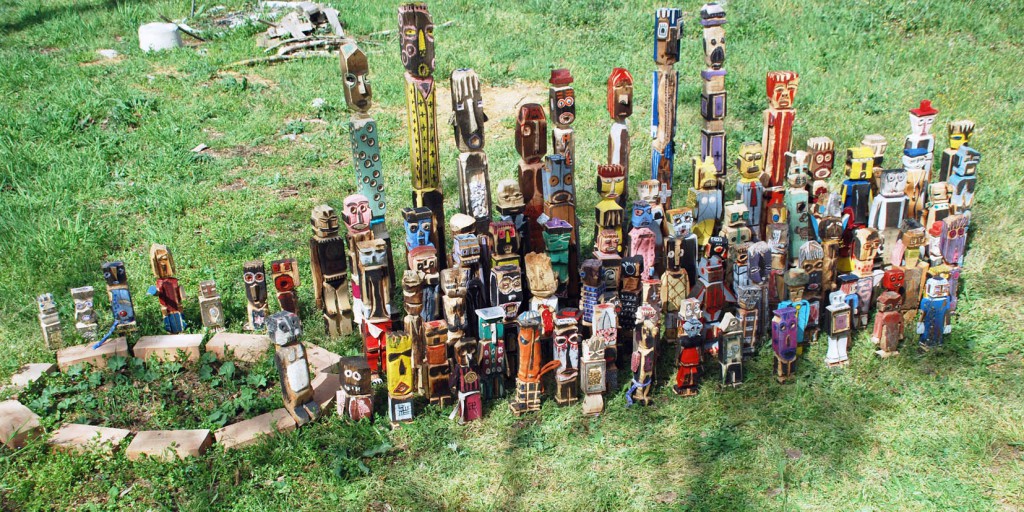
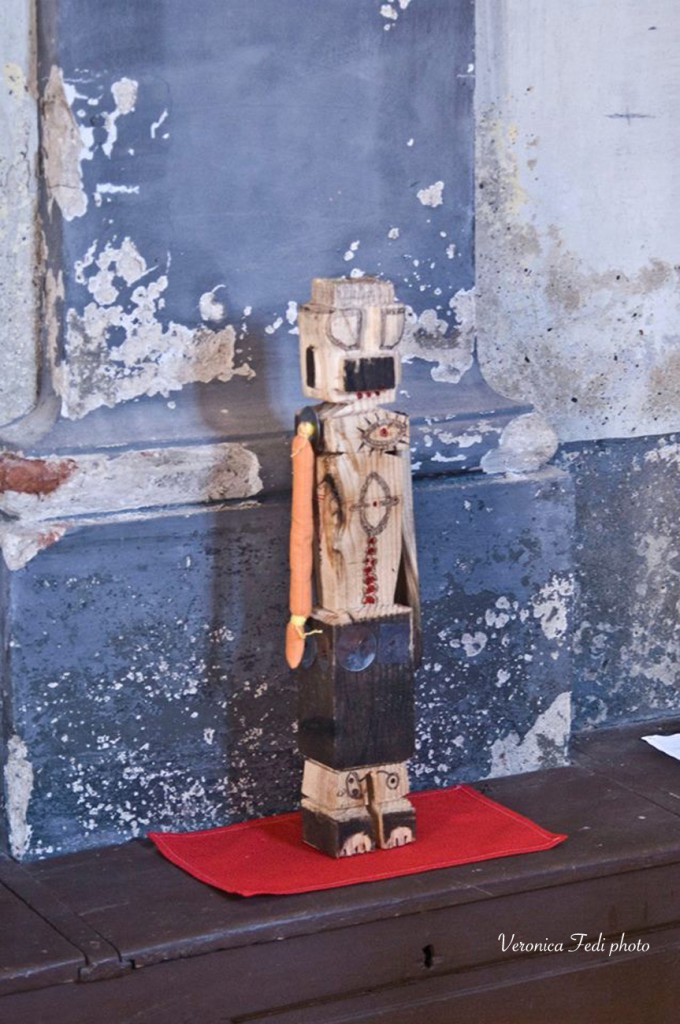
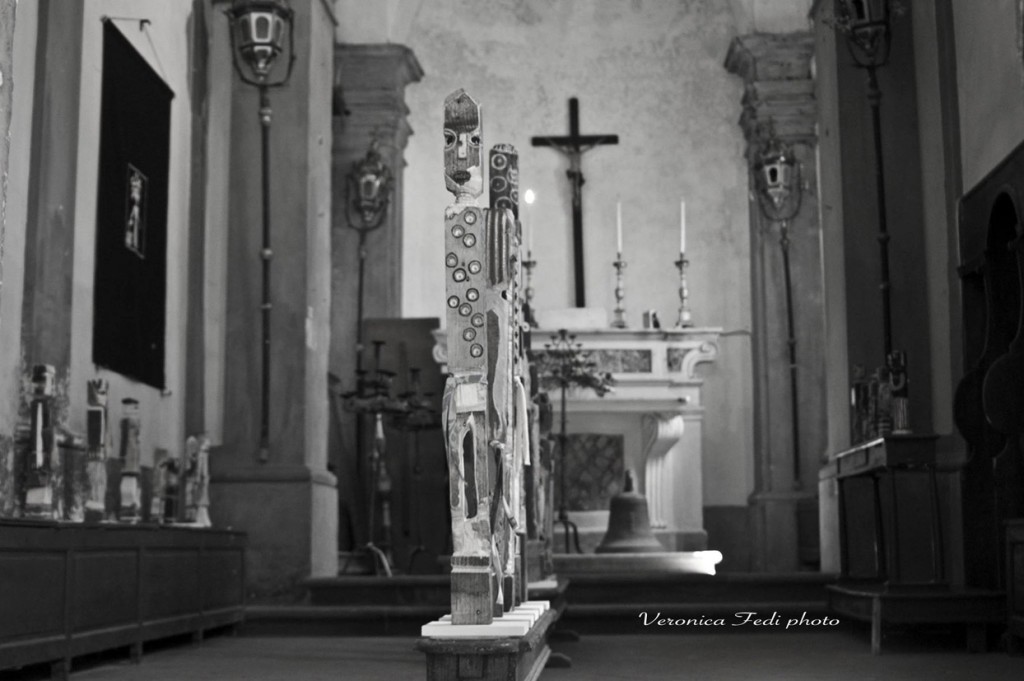
Dice Arnaldi of Map (Museum of Primary Art, Vendone SV), goes beyond the canon of how tribal art is defined in the world, and defines everything more specifically, defining this as Primary Art.
“Commonly the Primary Arts are the artistic expression of extra-European cultures, particularly African, Asian, Oceanian, which aim to conjure a state of consciousness instead of representing a specific reality; however, every creative manifestation that conjures an archetypical dimension, beyond the time and the space of its creation, and that is reminiscent of the essence of the human experience, can be defined Primary Art.. In this sense, the language of primary art has been used since the time of cave engravings to enquire the Mystery of Life (birth, death, joy, pain…) and to try to control it.”
No matter how you call it, this form of art exist, overcomes time and space and has survived until the present days; it is also a proof of a territory that summarizes the archetype and all the characteristics belonging to this kind of art.
Therefore we can say that in Serravalle Pistoiese it has been created, somehow, a bridge between past and present.
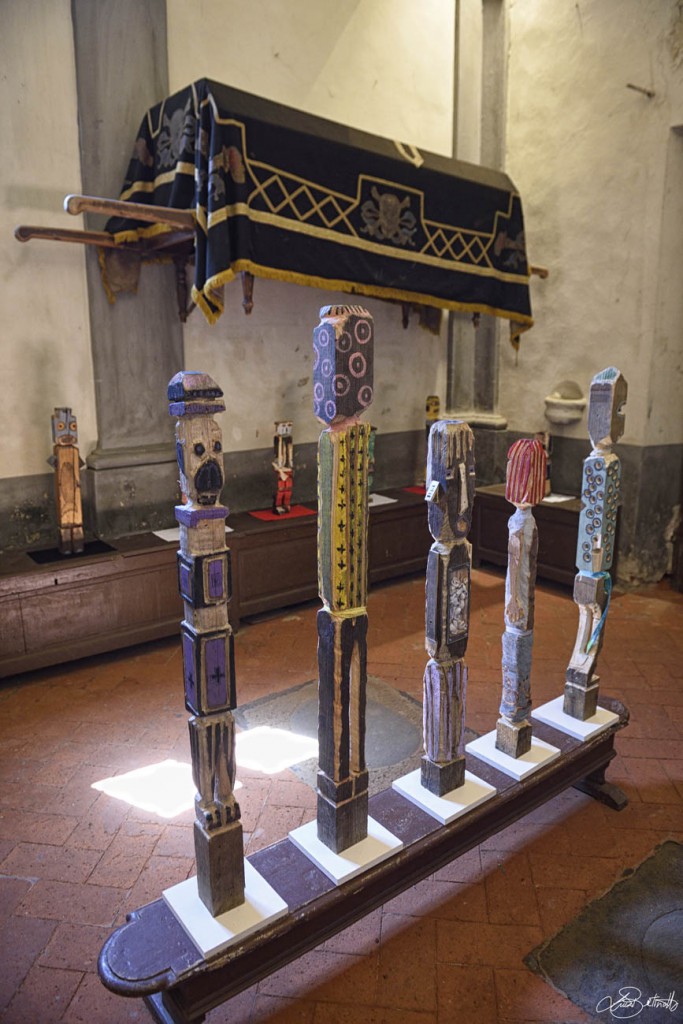
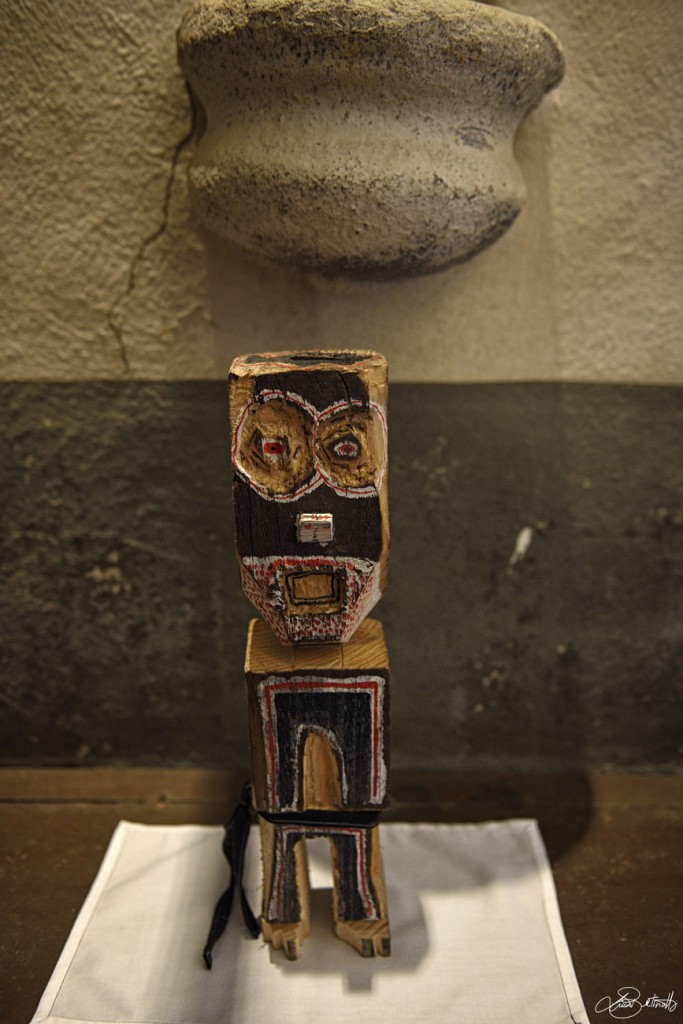
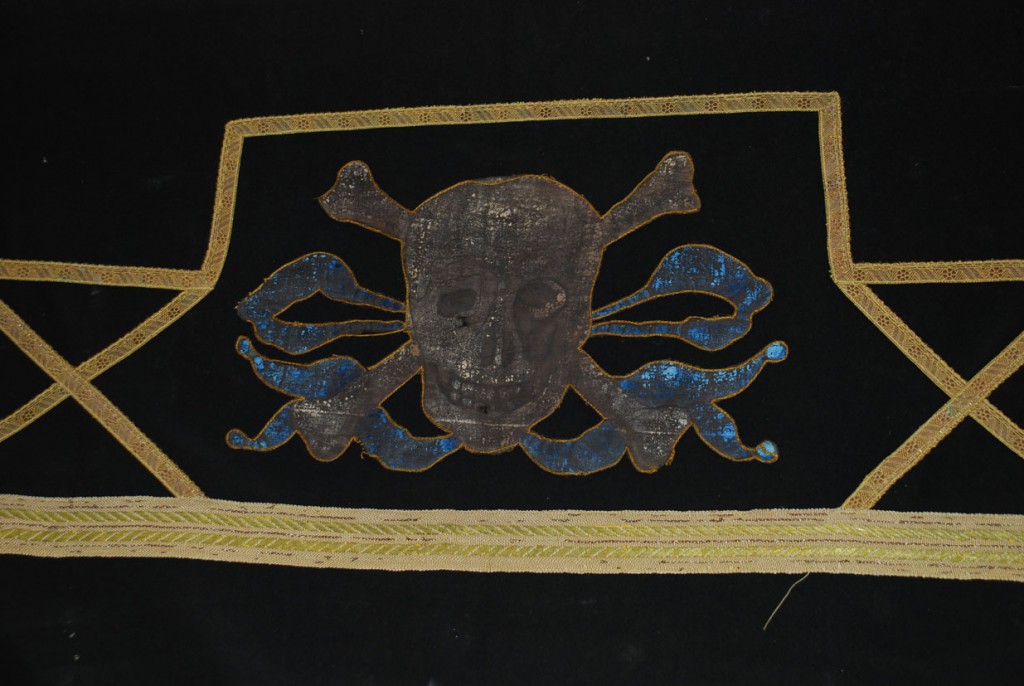
The exhibition takes place in the upper side of the town where approximately in the XIII century, by the will of Bishop Soffredo Soffredi, the church of Santo Stefano was erected. The church still preserve many signs of its Romanic origin. On the inside one can find two statues dedicated to St Stephen, and the Patron of Serravalle Pistoiese, St Louis (since I have mentioned symbols, archetypes and atavism I shall add a couple of curious coincidences: the Patron was born on 9th February 1275, I was born on 9th of February 1975; the street where I live is named after the sculptor that made the large crucifix inside the church). On the right side of the church is located the Chapel of SS. Sacramento, where the exhibit takes place.
Besides having hosted my “ritual dolls”, the chapel, which is the home of the Company del SS. Sacramento, also keeps a large and elaborated “Cross of Passion”. This observation gives me a starting point to recall a characteristic of our society, which, a long time ago, was very connected to the territory and its traditions: the so-called “Confraternities” or “Companies”.In order to offer a deeper discussion of the topic and to talk about our area, I rely on the text“The ancient lay confraternities in Serravalle castle”. The “lay confraternity” was born as an aggregation of people focused on playing an essential role for the community: each these usually had a specific task, to which the brothers dedicated their energies.in order to carry it out in the best possible way. They were open both men and women. More specifically, the confraternity of SS. Sacramento (or Sagramento) was established in 1590, and today, although it has strongly reduced its missions, is still active. The Chapel still preserves several characteristic traits of this function, like the lateral bench placed along the inner perimeter of the wall, that serve both as a seat and a container for the brothers’ shoes, capes and everyday objects. Furthermore, thelate Baroque age altar, that dates back to the year 1792/1793, and a wooden confessional made around the XVIII – XIX century, are still here.
Four lanterns with “moveable heads” rom the second half of 1700, used for processions or other outdoors purposes, stand out for their presence.fFrom the same period, there is a funeral stretcher mounted on the wall,, with its black blanket decorated with skulls. This is because the company took care of all the “uffizi” for the dead of brothers and sisters, which ranged from the transportation of the corpse to a Mass with a specifically chosen priest. At that time, religious and normal life were strictly connected, and collective mourning was strongly linked to the land.
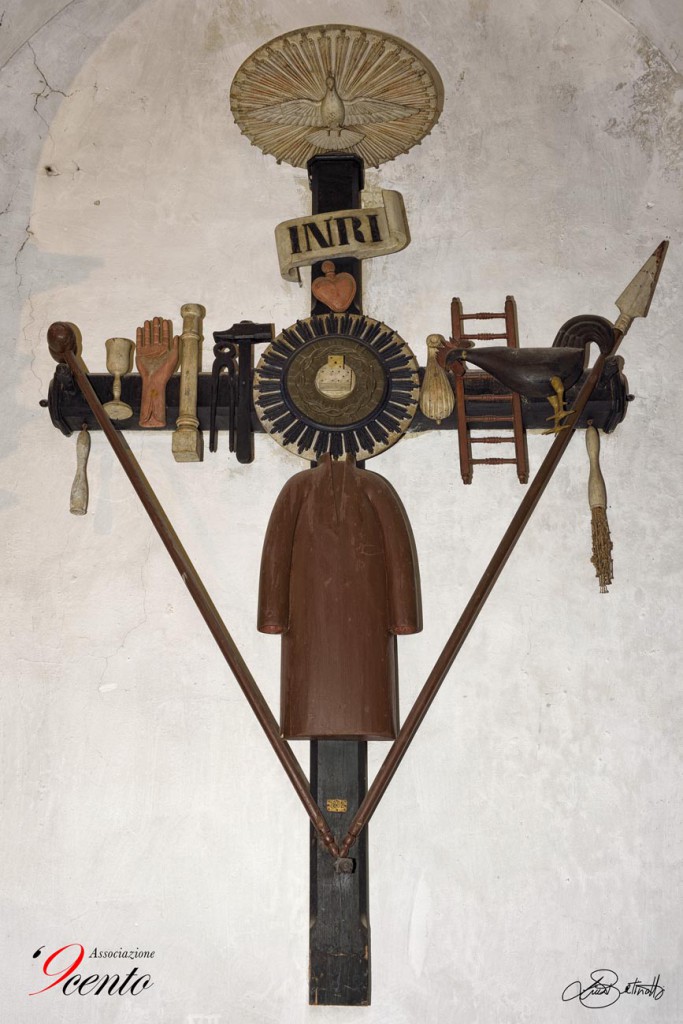
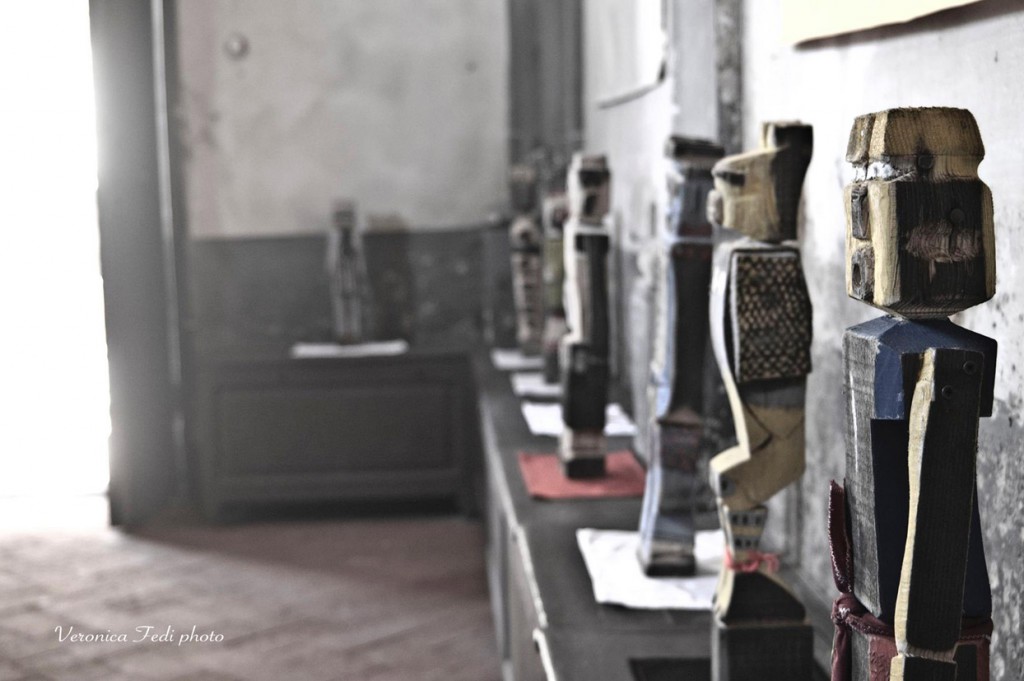
Nevertheless, this must not focus our attention only on the practical side of the building, because, as you can see from the photos that are included in the article, these strong bondsgave life to a powerful “artistic” expression, driven by “Passion” and love for the divine. The mystery of death is shown through the exposition of the very elaborated, both for colours and embroidery, black blanket that covers the funeral stretcher,.. It has very strong, impressive symbols connected to death, as if they were meant to seal a step that, sooner or later, has to be taken. At a closer look, the black blanket tells a story of sorrow. Nevertheless, if we better observe the skull, especially as it is surrounded by gold (in this case, there is the embroidery),we realize that it also recalls rebirth and eternal life. Here it is, what onlyseems onlyagloomy funeral sheet, made for remarking the funeral nature of the stretcher it is covering, is, in fact, a much more refined artwork that bears a deeper meaning. With the same attitude, we can also analyze the elaborated lanterns adorned with leaves, flowers and other objects that look like shells: allelements thatremind of life,femininity and care.
Even by examining only these two elements, it is noticeable how what said previously becomes true. Although today we tend to neglect the spiritual aspect in favor of the material one, we must not forget that men need to believe, they need to have faith. Faith gets strength from its rituals, from its ceremonies, from the love for the divine. Humankind never went throughe ages with calmness: invasions, wars, riots, famines, economic crisis and many others were its travel companions. What gave us t the strength to fight and move on was the Faith in something “higher” that could give us hope.
It is from the same spiritual, strongly believing perspective, and with a strong creed, that around the middle of 18th century another phenomenon of popular devotion appears; the Chapel is a keeper of this phenomenon, that particularly marks our territory: the “Passion Crosses”. This phenomenon was analyzed by an extremely accurate work of cataloguing and study by Luca Bertinotti in his book: “Le Croci del mistero. Origine, sviluppo e decline delle Croci della Passione”. In the book, the author traces a cultural line where first the Crosses are analyzed under their symbolic aspect, and then they are catalogued and collocated on Cartesian coordinates on the territory including a very detailed and rich photographic section. For lack of space, I suggest you to read his excellent book; here, sadly, I will only briefly mention their artistic/ritual meaning. The Passion Crosses were a phenomenon very present in our territory, especially in the area between the cities of Prato, Pistoia, Serravalle Pistoiese, Montecatini Terme and Lucca (northern Tuscany).It is very present here, but it is common, in a minor way, all over the world.. These crosses are almost always without the figure of Jesus Christ. They stayloyal to the original symbolism of the Passion of the Christ thanks to their peculiarity: on each plank, they have the arma Christi: cross, nails, crown of thorns, spear and the inscription with the reason of the sentence, which are the instruments that were used for the crucifixion of Jesus. But the strength of the representation goes even beyond this, and the most complete of these crosses are equipped with all the objects related to the passion of Christ. In any case, the symbolic chronology appeared very clear at the age of the productions of the crosses (for further more information, please referto the book):
The day before the Passion: the dove, symbol of the Holy Spirit, the palm branch, the goblet, the carafe, the Bread of the Last Supper, the tunic.
Garden Getsemani: the thirty Dinar, the Lantern, the Cock, the Rope.
The Trial: Figure like Judas, the Gloved Hand, the Sward of St. Peter, the Ear of Malco.
The Flagellation: the Sponge, the Pot, the Thorn Crown, the Reed, the Mantle, the Veil, the Pillar, the Whip.
The Crucifixion: the Skull, the Real Cross, the Cross of the Thief, the Dice, the Title Block, the Nail, the Hammer, the Lance, the Sun and the Moon, the wounded heart, the Pincers, the Afflicted Angels, the Stair, the Myrrh Pot, the Shroud.
All these symbols, made ofwoods oriron, makes us understand how much devotion, love and passion for mystery of God there was in the past. This type of crosses, that has survived until the present days, not only does bring us a message from the past that must necessarily look at the future, but also confirms once again our need to grasp onto Faith to face “dark” and uncertain moments, joint with the desire to thank who protects us from above. This creates inside humans a sense of longing for that “beyond”, for that spiritual dimension whose“visit” gives back to men the need to make artifacts, that, by all means, are art, apt for celebrating or praising him who they recognize like their God.
This specific typology of crosses, those of Passion, have always provoked my curiosity, so that they are very familiar for me today; similarly, some things mentioned by Luca Bertinotti’s book are familiar to me too. The person that roams the fields with a wooden stick to find water, the dowser, is familiar to me. The old lady who “blesses” herpes zoster, who “washses fear away” or “removes” fear and evil eye is even more familiar to me. They are familiar because there are so many, here, near my home. This might seem superstition, paganism, the legacy of a peasant culture that was based on “ignorance”. I prefer to put this term on inverted commas because –do not get me wrong- – I do not think absolutely like this. Actually, at the base of of all these phenomena lies an act of deep devotion. This happens because, when we go to carry out certain rites or certain ceremonies, the act of praying is constantly present and the request of help from God is fundamental and indispensable. I too have got my fear “washed away” several times, and so I know well what I am talking about.
Even during this rite we can see a sort of “ritual art” that, again, conforms to the theme of the Passion of Christ or to his sufferance: in fact, the objects used during this ritual are the Basin, the Bread,a particular grass, cut at the dawn of St. Joseph’s day, and a blessed wedding ring (and other, which is a secret)Then, here I am. I live in a territory that every day tell us a story, lost in the middle of a population that has a very ancient history and that has lived everything: from fairy legends to cults that have been lost, through sieges and so on.
Tangible proofs tell us that the artistic expression of ritual profile is strong, that over the last 500 years it has never stopped, but it has always been in continuous development. I’m proud to have the possibility to display my reliquary, anti-loneliness dolls and my images of ancestors in this Chapel, which is also a sort of receptacle for all this story and, consequently, of strong energies. This is the bridge I was talking about at the beginning: a link that starts in the past, in the 13th-14th century, then, in the 17th, and arrives in the present days.
I would dream to continue this story andto be part of its“future”, but I’m not obviously able to do so.. It is a fact that I am in love with my river, my field, my animals, my customs, with my work of Tribal Art and everything that my territory quietly, but harmoniously shows.
Filippo biagioli (european tribal art artist)
I thank with all my heart: The Town of Serravalle Pistoiese (PT), the Parish of St. Stephen (organization and material catalogue), Luca Bertinotti (Photography and documentary of Cross of Passion), Federica Belmonte and Alice Borchi (revision of the text) and Veronica Fedi (Photography and translation).
Questo per adesso è tutto
A presto
filippo
l’analphabeta
Nroomから度々展示に参加しているイタリア人作家Filippo Biagioliが、新作漫画を届けてくれました。日本語版のタイトルは「退屈」です。
日々の生活に何かが足りないと感じる時、何だか新しい事をしてみたい時、ちょっとだけ背中を押してくれる・・かも(たぶん?)
詳しくは以下をどうぞ。読んでみたい方はご一報ください。通常のFilippo作品も掲載中です。
http://nroom-artspace.com/Filippo.html